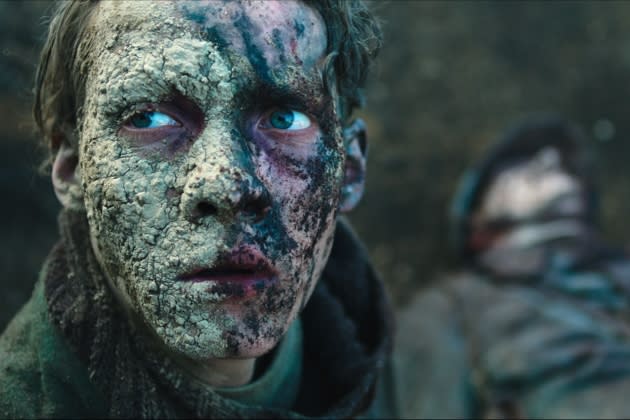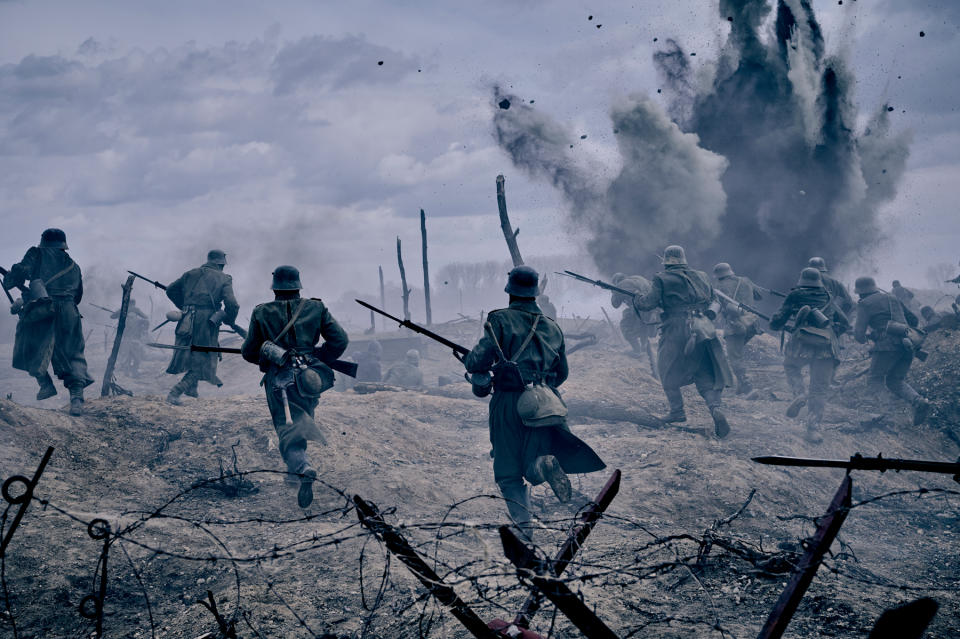How Did ‘All Quiet on the Western Front’ Become an Oscar Favorite?
- Oops!Something went wrong.Please try again later.

Every year, the Oscar nomination announcements tend to inspire shrieks of joy, yelps of surprise, and the loud gnashing of teeth and rending of garments. This year was no different, with gasps soundtracking Andrea Riseborough’s somewhat out-of-left-field (and controversial) Best Actress nomination for To Leslie, some scattered “hell-yeahs” accompanying Paul Mescal’s deserving Best Actor nod for Aftersun, and the sound of thousands of simultaneous facepalms after the appalling shut-out of several notable Black performers and female directors from the main categories.
But if you cocked your ear skyward on the morning of January 24, 2023, you might have also heard a collective “Huh?!” faintly echoing in the distance. That would be the response that greeted All Quiet on the Western Front receiving no less than nine nominations from the Academy. To be more specific, it was the antiwar film’s final nomination that had caused such a mass headscratching.
More from Rolling Stone
Cast Your Vote: Here's Where to Download a 2023 Oscar Ballot Online
Oscars Still #SoWhite, Despite Some Improvements in Nominee Diversity
A new adaptation of Erich Maria Remarque’s classic 1929 novel, director Edward Berger’s take on the journey of a young man from patriotic new recruit to shellshocked soldier in the trenches of World War I is somehow grimy and glossy, gussied up like a prestige drama yet gorier than a horror film. It’s the third version of the book, though the first to come from Germany — a notion that radically changes the perspective of how The Great War was won and lost, while still sticking to the thesis that war is hell no matter what side you’re on. And it can be viewed as being part of a long tradition of past Oscar nominees, in which the blunt-force impact of violent, brutal imagery is designed to wallop moviegoers into both submission and a state of dazed contemplation. (Looking at you, Saving Private Ryan and Hacksaw Ridge.) We’ve been so shaken and battered by what we’ve seen, so we guess that must mean that we’re also incredibly moved by it as well?
And still: When All Quiet on the Western Front was announced as one of the 10 contenders for this year’s Best Picture Oscar, there was a slight sense of confusion. Had someone accidentally handed Riz Ahmed and Allison Williams an envelope from 1930? (That was the year that Lewis Milestone’s original adaptation won Best Picture.) This was the Netflix film that premiered at the Toronto International Film Festival back in September, with nary a ripple, right? And barely got any theatrical release of note when it was released in the beginning of October, before hitting the streaming service at the end of that month? We’ll have to take the company’s word about the numbers that it pulled that first week, but we can confirm it was more or less M.I.A. from most year-end lists, critics groups’ awards, and the majority of Oscarologists’ breathless discussions.
But here it was, right behind Everything Everywhere All at Once in terms of stats — the A24 multiverse dramedy has 11 nominations — and tied with The Banshees of Inisherin for second-most-nods status with nine each. Both of those other films entered the Oscars race with a lot of critical kudos, strong word-of-mouth campaigns and, in Everywhere’s case, a level-up from immediate audience favorite to actual box office hit. Quiet’s haul is big on technical categories, which isn’t hard to imagine: It’s an anti-war film that prides itself on showing you the horrors of war in the most visceral, VFX-friendly ways possible. The film’s inclusion among the Best Cinematography nominees felt odd, only because it had such stiff competition. (Whither Everything Everywhere, which felt like it mixed and matched a half-dozen distinct looks? Or the time-machine-level retro look of Living? Or Till? The Fabelmans? The Woman King? Freakin’ Top Gun: Maverick?!) Best Adapted Screenplay? Fine. Best International Feature? OK, sure.
But Best Picture?
This is where you attempt to triangulate the factors that may have pushed this into becoming an Oscars favorite vying against far more publicized, “Oscar-worthy” entries. The first would obviously be Netflix. The streaming service may not be Harvey-in-his-heyday savvy or shameless when it comes to Oscar campaigning, but it’s learned from past mistakes and continues to have incredibly deep pockets come awards time. It picked up the film in December 2020, which was enough to make headlines in the trades.
Yet outside of technical categories or a potential International Feature bid, Netflix appeared to be running a stealth campaign compared to its English-language movies. Edward Berger had mostly worked on impressive TV series like Deutschland 83, but this was a project with far more ambition and scope. The only star with name recognition outside of Germany was Daniel Brühl, and his role as an official attempting to negotiate a cease-fire is relatively small. The serious FYC ads and bonus bells and whistles, i.e. your making-of featurettes and below-the-line Q&As, didn’t start showing up until after the nominations were announced and Netflix realized they had something with red-carpet potential, at which point they became ubiquitous.
Clearly a number of Academy members saw it, however, and probably not on the streaming service, where the sound, the fury, and the spectacle that Berger conjures in his retelling doesn’t have the same impact as it does on a big screen. Which brings us to a potential second factor: a fixed idea on what makes something “an Oscar movie.”

The Academy’s A2020 initiative had, in addition to addressing racial and gender inequity in its voting body, helped introduce a generation of new members who weren’t tied to traditional ideas of Best Pic pomp-and-circumstance. But there are still plenty of AMPAS folks who cling to an age-old paradigm. Thanks to the 1930 version’s O.G. Best Picture status, All Quiet on the Western Front would definitely have name recognition with that demographic — how many hundreds of times has the original’s signature shot of a hand reaching out to a butterfly played during best-of montages? Even a cursory glance at the current version’s trailer tells you a.) it aims to be an epic movie, b.) it will be unsparing in its depiction of the horror, the horror, and c.) it’s intent on making a grand statement that didn’t require subtitles to understand, even if the dialogue did. Given the movie’s dedication to showing you exactly what the machinery of warfare does to the human body, in highly graphic and gory detail, you’d think the scenes of carnage might be off-putting to many voters. But remember that earlier statement about ultra-realistic warfare equaling emotional profundity? It’s a textbook case of a movie that makes you feel bad when you watch it and good when you vote for it.
Berger’s film still seemed like an outlier until the BAFTAs, which gave the film 14 nominations and eventually handed it seven awards, including Best Picture. To say this momentarily threw a wrench into the idea that this year’s Oscars would be a cut-and-dried affair is understating things. As New York Times reporter Kyle Buchanan pointed out, the British equivalent of the Academy Awards has some overlap with its American counterpart in terms of voters, while the Los Angeles Times and several other outlets have noted the ongoing fighting in Ukraine has added an extra sense of relevancy to the movie’s anti-war message. Not that All Quiet’s message has ever not been relevant — it’s just that the toll that nonstop combat takes on those willing or forced to take up arms is something in the forefront of many minds right now. And if there’s one thing you can say Berger’s film does well, it’s that it makes you feel as if you’re being bombarded in the trenches next to these young men.
Since the BAFTAs, the film’s profile has been given a bit of a glow-up and it’s considered the favorite for the Best International Feature award, though Everything Everywhere All at Once’s back-to-back wins at the Directors Guild Awards, the Screen Actors Guild awards, and the Producers Guild Awards (the last being a reliable Best-Pic bellwether) have now made that movie the Best Picture frontrunner. Still, as Michael Schulman’s recent capsule history of the award show Oscar Wars reminds us, there’s no such thing as an Oscars sure thing, it’s all up in the air until the envelope is opened and chaos reigns. Anything can happen. The fact that this massive blockbuster-style adaptation of a literary-canon novel, backed by a huge streaming service, was once considered an underdog — before it was considered much at all outside of its home country — then suddenly garnered a slew of Oscar nominations and serious-contender chatter is simply one of the more inexplicable turns in this year’s race. By the time the ceremony ends, you can bet it won’t be the most inexplicable turn.
Right after the BAFTAs win, I finally caught up with All Quiet on the Western Front at a theater near me in New York. It opens with a brief, Saving Private Ryan-style sequence in which an unknown soldier follows his regiment into “No Man’s Land,” sees his peers gunned down, and kills several enemy troops before meeting his maker. We then see his uniform removed from his corpse, and sent to a laundry. The bullet hole in his shirt is sewn up by a seamstress in a factory. It’s delivered back to a military office, where it will be given to a new recruit named Paul, played by Austrian actor Felix Kammerer. He innocently notes the name tag of another solider on the garment, and is told by an officer that the uniform probably didn’t fit the other man. He rips the tag off and throws it on the floor, where it now lies next to a number of similarly-discarded tags. Rinse (literally) and repeat.
It’s both the most inspiring sequence in this new All Quiet, doubling as a fine example of how the movies’ show-don’t-tell methodology can map the industrialization of warfare for maximum wallop, and one of its most heavy-handed. Which is also a good way of summing up the film as a whole; for every grace note (like a sequence in which Paul and a fellow soldier talk while an aerial dogfight happens way, way off in the distance), there are a dozen scenes that mean to pummel you by any and all means necessary. No one wants a timid version of Remarque’s cri de couer, yet in a number of instances the film seems to identify less with Paul than with the tanks that roll over screaming men and crush everything in their paths.
There are enough visual echoes of Lewis Milestone’s 1930 adaptation and enough famous bits recreated from the novel that you can tell it takes its source material and its screen ancestry seriously. (Whether Berger’s movie is thematically and spiritually faithful to the book is something for smarter writers than I to decide.) As the end credits rolled, I was left with the sensation of having seen something that was technically proficient, neither soulless nor soulful, and steeped in a throwback grandiosity that occasionally made up for its deficiencies in other areas (and often didn’t). It is a massive, majestic mediocrity, in other words. Which, the more I look at the history of the Oscars — what it rewards, when it rewards it, and why — makes me think this All Quiet on the Western Front still has a strong chance of walking home with that grand-prize gold statuette after all.
Best of Rolling Stone

